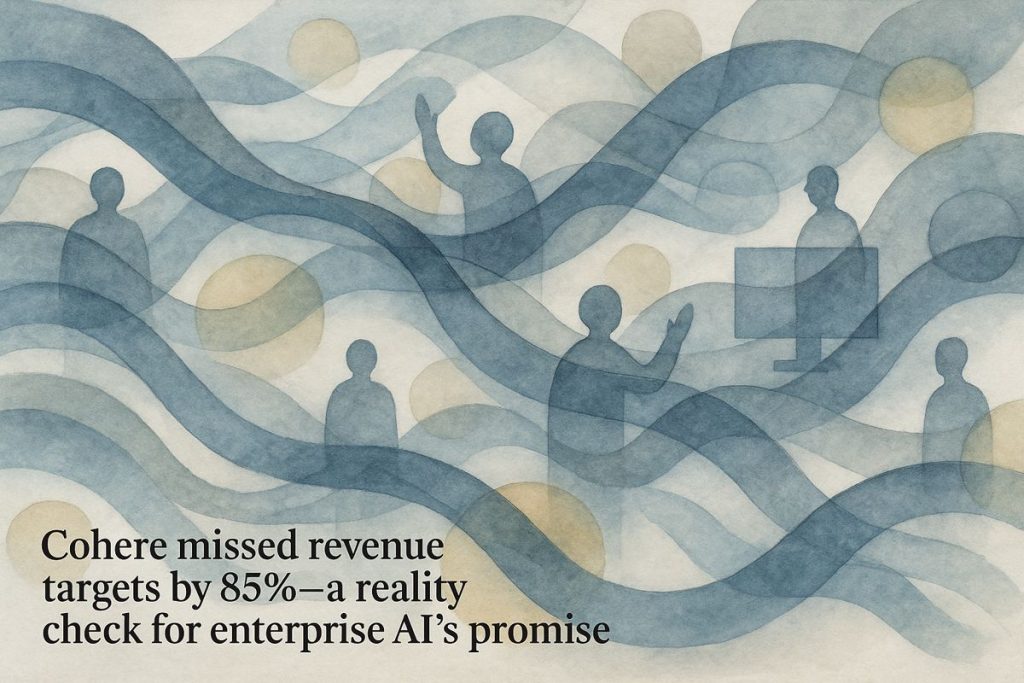Cohere missed its 2024 revenue goals by a huge 85%, earning just $30 million instead of the $450 million they expected. The main reasons were tough competition and slow adoption of AI by big companies, which often face lots of rules and technical hurdles. To fix this, Cohere shifted its focus to secure, private AI services for sectors like finance and healthcare, doubling its revenue and boosting profits. Investors still believe in Cohere, raising its value and pouring in more money, while the company now bets on specialized, safe solutions instead of flashy, broad AI promises. The real challenge for Cohere�26mdash;and others�26mdash;is not the AI itself, but getting old-school businesses to actually use it.
What caused Cohere to miss its revenue projections, and how is it responding?
Cohere missed its 2024 revenue projections by 85%, generating $30 million instead of the expected $450 million. The shortfall stems from enterprise AI adoption challenges and market competition. In response, Cohere shifted focus to secure, private deployments for regulated industries, doubling revenues and improving profit margins.
Smoke, Mirrors, and Uncomfortable Arithmetic
Let�27s address the laconic elephant in the room: Cohere, the Canadian darling in enterprise AI, recently managed to miss its own revenue projections by a brisk 85%. (That�27s not a typo. Eighty-five. Even the Montreal Canadiens would blush at a defensive lapse like that.) Instead of raking in a triumphant $450 million by the end of 2024, they ended up with a modest $30 million, according to The Information and TapTwiceDigital. You might be tempted to gasp�26mdash;or perhaps just groan�26mdash;but wait, the plot thickens.
Despite that eyebrow-raising gulf, there�27s an undercurrent of frenetic growth. Revenues doubled from $13 million in 2023 to $30 million in 2024. That�27s not exactly chump change, and by May 2025, Cohere claimed annualized revenue of $100 million. It�27s the sort of �22hockey stick�22 curve that would make any venture capitalist�27s pulse quicken�26mdash;until, of course, one remembers that a hockey stick also has a long, ominous flat part before you hit the blade. I had to stop and ask myself: Is the AI gold rush more fool�27s gold than gold, at least so far?
If you�27ve ever tried to explain an 85% miss to a boardroom of caffeinated investors, you know the feeling�26mdash;a mix of dread and defiance, the scent of burnt espresso, and the hum of a projector stalling out. Been there, once, with an old startup that promised �22revolutionary�22 data pipelines. Spoiler: the revolution was delayed.
From Megamodels to Microservices: Pivots and Palimpsests
Cohere�27s original game plan was to wage battle on the hyperspectral field of foundational models, aiming to outgun the likes of OpenAI and Google. But if there�27s a universal law in the AI cosmos, it�27s that most enterprises don�27t want to build their own palimpsest of bespoke models�26mdash;they want solutions that work out of the box, behind the firewall, and won�27t trigger a compliance fire drill at dawn.
Cue Cohere�27s pivot, equal parts necessity and ingenuity. By 2025, about 85% of their revenue stemmed from private, on-prem or virtualized deployments�26mdash;think regulated sectors like finance, healthcare, and government. They went full-bore into the application layer with �22North,�22 an enterprise knowledge assistant piloted by the likes of RBC and LG. These deployments aren�27t just plug-and-play; they�27re more akin to installing a submarine in your office basement�26mdash;complex, weighty, and requiring an expertise that borders on the arcane.
I�27ll admit, I once scoffed at the fuss over data residency. Then, during a client engagement with a Swiss insurance giant, I watched a legal team debate GDPR compliance for six hours straight. The sound of espresso machines behind closed cafeteria doors was the only thing keeping us sane.
But Cohere�27s approach appears to be paying off. Margins on these private deployments reportedly hover around 80% in 2025�26mdash;a number you can�27t just hand-wave away, even if the revenue total isn�27t stratospheric yet.
Capital, Competition, and the Curious Case of Cognosys
You�27d think such a resounding miss would spook the markets. Not so. Cohere�27s valuation ballooned from $2.2 billion in mid-2023 to $5.5 billion in July 2024, thanks to deep-pocketed partners like Nvidia and Cisco, and more than $900 million raised. This is the kind of cash that makes even the most jaded quant salivate. Somewhere in the mix, Cohere acquired Cognosys�26mdash;a scrappy AI agent startup�26mdash;to bolster its enterprise platform The Information.
The competitive terrain is, well, bristling. OpenAI and Google are entrenched like 19th-century generals�26mdash;fortified, well-funded, and not easily dislodged. Yet Cohere has managed to lure clients such as Fujitsu, Oracle, and Notion. Their secret sauce? A potent cocktail of domain specificity and ironclad security, with a whiff of regulatory gravitas.
Sometimes I wonder if the race is more marathon than sprint�26mdash;if the real victors will be those who can slog through the regulatory trenches, not just dazzle with demos.
Why Enterprises Drag Their Feet: The Unvarnished Truth
Let�27s not sugar-coat it. The greatest bottleneck isn�27t the tech�26mdash;it�27s everything else. Integrating generative AI into legacy IT feels like stitching quantum circuits into a Victorian corset. Data silos, Byzantine security frameworks, and regulatory labyrinths delay even the most ambitious deployments. EPAM�27s 2025 study pegs production-level AI adoption at a meagre 26% among �22advanced�22 enterprises [EPAM Press Release].
